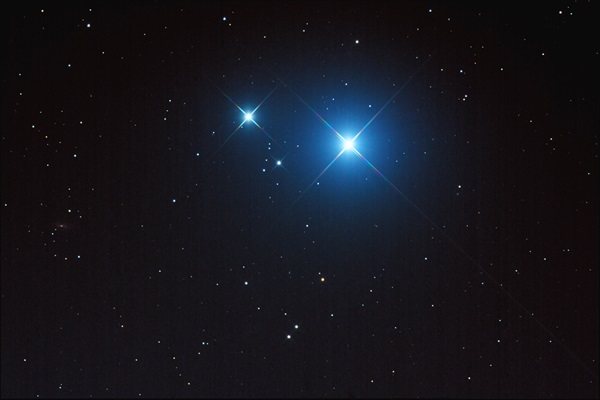The Sky This Week from July 19 to 28 – Astronomy Magazine
A fine summer double
The bright star Mizar marks the bend in the Big Dipper’s handle. Binoculars reveal a somewhat fainter star, Alcor, just to its east (left). People blessed with good vision can often split this pair with the naked eye.
Gregg Ruppel
The Big Dipper’s familiar shape appears halfway up the northwestern sky as darkness falls. One of the summer sky’s finest binocular double stars marks the bend of the dipper’s handle. Mizar shines at 2nd magnitude, some six times brighter than its 4th-magnitude companion, Alcor. Even though these two are not physically related, they make a fine sight through binoculars. (People with good eyesight often can split the pair without optical aid.) A small telescope reveals Mizar itself as double — and these components do orbit each other.
Tuesday, July 23
Although Jupiter reached opposition and peak visibility more than a month ago, it remains a stunning sight from shortly after sunset until the wee hours of the morning. It resides among the background stars of southern Ophiuchus the Serpent-bearer, a region that climbs highest in the south around 10 p.m. local daylight time. Shining at magnitude –2.5, Jupiter is the night sky’s most conspicuous object until the Moon rises shortly after midnight. When viewed through a telescope, the planet’s disk spans 44″ and shows striking cloud-top detail.
Wednesday, July 24
Last Quarter Moon occurs at 9:18 p.m. EDT. It doesn’t rise until after 12:30 a.m. local daylight time tomorrow, however, by which time its phase has diminished almost imperceptibly to 48 percent lit, at least for those of us in North America. Earth’s satellite appears against the relatively inconspicuous background stars of northern Cetus the Whale.
Thursday, July 25
Observers of the outer solar system can get a good view of Uranus before dawn. The best time to look for it is shortly before twilight begins around 4 a.m. local daylight time. Uranus then lies 40° high in the east-southeast against the backdrop of southern Aries the Ram. This morning, use binoculars to find the magnitude 5.8 planet 2.3° south of the magnitude 5.7 star 19 Arietis. A telescope reveals Uranus’ blue-green disk, which spans 3.5″.
Friday, July 26
The Southern Delta Aquariid meteor shower continues to ramp up this week. The shower has a broad maximum at the end of July, but you should see some members in the hours before dawn. And with the Moon now diminished to a waning crescent, the views improve nightly. To tell a Southern Delta Aquariid meteor from a random dust particle burning up in Earth’s atmosphere, trace the streak of light’s path backward. A shower meteor will appear to originate from the constellation Aquarius the Water-bearer.






